Gallin leads journalists on CRC grand tour
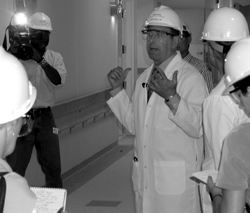 Dr. Gallin (center) explains new functions of CRC to reporters.
Dr. Gallin (center) explains new functions of CRC to reporters.
|
To see the inside of the new Mark O. Hatfield Clinical Research Center (CRC), one still has to don protective glasses and wear a construction hardhat. There's still the smell of machinery and freshly cut wood. And of course there's the noise.
But it's far from what it was a mere two months ago. Tiling and countertops are being installed, the labs are beginning to look like labs and it's already looking like a hospital—one that not only is pleasing to the eye, but is state of the art.
The media are beginning to notice. On July 12, NIH Director Dr. Elias Zerhouni hosted a media briefing attended by reporters from the American Medical News, Chemical and Engineering News, Cox Newspapers, Nature, U.S. Medicine, Wall Street Journal, Washington Post, WRC-TV4 and WUSA-TV9.
"There is no facility like it in the rest of the world or the United States," Zerhouni said in opening remarks. "You'll see labs and clinical facilities coming together in a way that doesn't exist anywhere else."
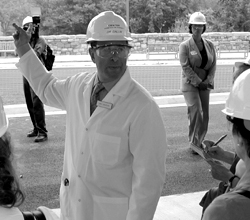 After showing the media the innovations on the inside of the CRC, Dr. Gallin leads the media representatives outside to show off the landscaping, which is designed to relieve stress and create an environment conducive to healing and well-being.
After showing the media the innovations on the inside of the CRC, Dr. Gallin leads the media representatives outside to show off the landscaping, which is designed to relieve stress and create an environment conducive to healing and well-being.
|
The briefing also included remarks by Clinical Center Director John I. Gallin and Robert Frasca, design partner for Zimmer Gunsul Frasca Partnership, the CRC architects. Frasca called the research center "a worthy and functional tribute to the work that happens here."
Gallin, who conducted the tour, explained in his remarks why the CRC is so unique.
"I had a friend with AIDS who gave me some feedback," said Gallin in his introductory remarks. "It was a week before he died, and he said, 'You know something? It'd be a lot easier on patients to take a shower when they have a intravenous line in them if the nozzle were lower.'" Gallin acted on the suggestion, stipulating that showers in the new building have adjustable nozzles that can be moved up or down.
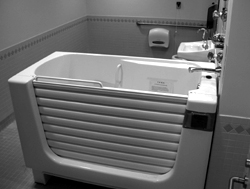 One of the new washrooms in the CRC built to accommodate patients that find it difficult to move around or bathe.
One of the new washrooms in the CRC built to accommodate patients that find it difficult to move around or bathe.
|
Gallin said that much of the success of the new building has come from listening to the experts. This includes the architects, builders, hospital staff and, most important, the patients.
The courtyards are filled with trees, providing an environment to help reduce stress. "I guess if the patients can't go to the trees, the trees will come to the patients," said one journalist, peering out a window.
Still another marveled at the imitation wood floors and the spacious Science Court, which invariably turns the eyes of first-time visitors upward to see the nine-story atrium looming above.
"I didn't expect a visit to a facility like this would be exciting," one journalist said to her cameraman, "but this is marvelous. Look at that court!" She later did a take in one of the patient restrooms, explaining how it had been specifically designed for patients' ease and comfort.
Gallin praised each innovation as the reporters crowded around him, scribbling notes or holding microphones in front of him. "He can give a tour faster and better than any of us can," whispered Don Sebastian, CRC project manager, as Gallin fielded questions.
As the tour concluded, someone collecting glasses and hard hats from the attendees reached out to take Dr. Gallin's. Gallin instinctively shook hands instead, then, realizing it was his hard hat the person was reaching for, held it up—smiling and showing his name on the front.
"This is mine," he explained.
-by John Iler
Back
to Top
Making a difference:
Leitman receives award for hemochromatosis work
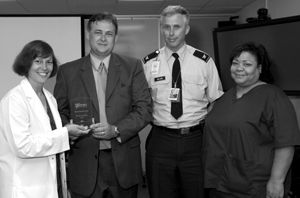 Dr. Susan Leitman (left) receives the Making a Difference Award from Randy Alexander, chairman of the Iron Disorder Institute. With them are Dr. Charles Bolan (in uniform) and Glorice Mason, team leader of the Donor Room Staff. Leitman, Bolan and Mason are all members of the DTM Hemochromatosis Protocol Team.
Dr. Susan Leitman (left) receives the Making a Difference Award from Randy Alexander, chairman of the Iron Disorder Institute. With them are Dr. Charles Bolan (in uniform) and Glorice Mason, team leader of the Donor Room Staff. Leitman, Bolan and Mason are all members of the DTM Hemochromatosis Protocol Team.
|
Susan Leitman, M.D., chief of Blood Services in the Department of Transfusion Medicine, received the Iron Disorders Institute's prestigious "Making a Difference" award this month.
The Institute's annual award was presented to Leitman for her work improving care for patients with too much iron in their blood—a disorder than can lead to early death if not treated by regular blood drawings (see "Celtic curse opens new doors for blood banks," January 2003).
The IDI is a national patient advocacy organization founded by Randy Alexander, who serves as chairman of its board of trustees. "Randy has hereditary hemochromatosis and is a participant in the DTM's hereditary hemochromatosis donor protocol," said Leitman.
The condition, dubbed the "Celtic Curse" by some, is more commonly known today as hereditary hemochromatosis (HH). Its effects can be devastating: arthritis, fatigue, heart palpitations, nonspecific stomach pain, impotence, loss of menstruation, and infertility. In advanced stages, the skin can take on a gray or bronze hue, and serious problems—such as cirrhosis of the liver, liver cancer, diabetes, heart and joint disease, severe fatigue, cardiac arrhythmia and congestive heart failure—may develop, resulting in disability or death.
"It's one of the most common genetic disorders in persons of northern European Caucasian descent," said Leitman. "Many people don't even know they have it, although it affects them from early childhood." According to Leitman, one in 200 people in this risk group suffers from HH. She believes it should be tested for at infancy or in childhood.
"Dr. Leitman received this award for her extraordinarily well deserved work as a clinician, medical doctor and research scientist," said Alexander. "NIH has demonstrated, under her auspices, tremendous forward thinking in designing an outstanding program yielding significant data and publicizing HH." The NIH protocol on HH, he added, involves 200 participants. Nearly 18 percent of the blood received at the NIH Blood Bank comes from patients with HH.
The award is typically given at NIH's Lister Hill Auditorium. This year's conference was held May 13-14, but Leitman was unavailable to attend. So Alexander arranged to have the award presented on July 8. To present the award, he drove to NIH, bringing with him a huge chocolate layer cake, half a dozen bottles of non-alcoholic sparkling cider, and "many dozens of red roses," said Leitman. "That was enough to give several roses to each of the NIH nursing staff that have participated in the care of HH subjects."
In accepting the award, Leitman expressed her delight in caring for patients so highly informed and educated about their condition, and about how personally rewarding it is to be able to improve the quality of their care. She considered the award ironic (no pun intended) "because blood donations by people with HH constitute 15 percent of all the blood units collected in DTM and transfused to Clinical Center patients." By participating in the DTM protocol, those with HH "not only get the best, most expert and informed care, but they help save other lives while being treated. That is the paradigm that IDI was honoring with this award."
Because of some of the work the Clinical Center is engaged in, its blood supplies remain at critical levels. DTM officials are actively asking employees and contractors for blood contributions. Said Al Decot, donor resources coordinator, "We're in such dire need we've even had to make emergency announcements on the public address system, calling for blood."
For those interested in learning more about hereditary hemochromatosis, its symptoms and treatment, visit Alexander's website (www.irondisorders.org). Most of IDI's activities center on helping HH patients get appropriate diagnostic and therapeutic care and advocating for better education for both doctors and patients.
Those interested in giving blood should call 301-496-1048. The status remains at critical.
Back
to Top
The boy in the plastic bubble: Looking back at the boy looking out
 Ted DeVita was the inspiration for John Travolta's character in the 1976 made-for-TV movie, Boy in the Plastic Bubble.
Ted DeVita was the inspiration for John Travolta's character in the 1976 made-for-TV movie, Boy in the Plastic Bubble.
|
The "boy in the bubble" became part of popular medical lore in 1976, with the made-for-TV movie The Boy in the Plastic Bubble. In the film John Travolta—playing Tad, a boy whose immune system is severely compromised—leaves the plastic-enclosed room that protects him from other people's germs and walks away down the beach.
The real story, however, ended far differently. It began in 1972 at the dinner table of NIH cancer researcher Vince DeVita, when his wife remarked that their nine-year-old son, Ted, had huge purple "blotches" all over his legs.
As an oncologist, Ted's father knew immediately that the bruises could indicate serious illness, and they did: severe aplastic anemia, a rare disease in which the body is suddenly unable to produce new blood cells and platelets.
Ted was admitted to the Clinical Center and lived there in a sterile room for eight and a half years. Ted's younger sister, science journalist Elizabeth DeVita-Raeburn, was six when Ted became ill.
The Clinical Center doctors and nurses who cared for Teddy, as the nurses called him, will see him as more than a near-legendary patient in Elizabeth's compelling account of his—the family's—life in Building 10. In The Empty Room: Surviving the Loss of a Brother or Sister at Any Age (Scribner's), Elizabeth writes that Ted's illness and death became the defining experience of her life, though it was years before she realized it.
Ted's story is background to her book's real theme—why "the loss of a sibling, which can be a crippling blow to our understanding of who we are, and how we function and relate to others," is so often considered less significant than other losses.
In about half the cases, scientists don't know what causes aplastic anemia. In the search for answers to what happened to Ted, Elizabeth reports, researchers autopsied the family parakeet, who died the day after Ted went into the hospital; tested the glue he used to make model airplanes (one ingredient of which was a suspected trigger for his orphan disease); checked which antibiotic Ted had taken shortly before he was diagnosed (another suspected trigger); and worried about a box of oranges someone had sent from Florida, so coated in pesticides that they were thrown out—but not before Ted had eaten one.
They never learned what precipitated the disease. The only hope of a cure then was a bone marrow transplant—a therapy developed in the 1960s in response to aplastic anemia—and Elizabeth and her parents were not good matches. While scientists and physicians tried all the other known approaches to dealing with his condition, Ted was isolated in a room on 13-East created to protect leukemia patients whose immune systems had been destroyed by chemotherapy.
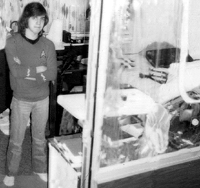 A bright and curious boy, Ted was a strong-willed teenager, permanently grounded, never, ever touched.
A bright and curious boy, Ted was a strong-willed teenager, permanently grounded, never, ever touched.
|
The "laminar airflow room" in which Ted lived had opened for the first cancer patient in 1969. Larger than the earlier "Life Island," a bed surrounded by a plastic bubble, the laminar airflow room allowed Ted to walk around. He lived surrounded by plastic sheeting containing a door-sized space through which things and occasionally doctors could pass in and out. He was surrounded by a "curtain" of air, a steady outflow of positive air pressure to expel potential pathogens.
On the few occasions he left on outings with the family, he did so encased in a spacesuit and helmet, with an air pump that expelled pathogens—an outfit that drew so much attention that he rarely left his room. (The only time he wasn't stared at was at a Star Trek convention.) Before Ted was confined to his room, the longest a patient had stayed there was several months. The hope was to sustain him with isolation and frequent transfusions until he recovered spontaneously or they found a treatment that worked.
For years, the Clinical Center was a second home to Elizabeth, where she remained the younger sister Teddy loved and teased. He was a bright and curious boy, then a strong-willed teenager, playing his guitar, permanently grounded, never, ever touched.
From the medical notes, Elizabeth learned that the staff saw Ted as "alternatively hostile, angry, and cheery," experiencing tantrums (especially the first year), throwing things from "The Room," hiding thousands of pills in a cavity in the wall because he hated taking them.
Ted's death May 27, 1980—caused mostly by iron overload from too many transfusions and no chelation—came as a shock to Elizabeth, as unexpected as a car accident. At the time, she didn't realize how life-threatening Ted's condition was. She realizes now how courageous he and her parents were.
After Ted's death, Elizabeth's parents never talked about him—a common way of coping and trying to "protect" the surviving sibling, but one that suppresses grieving. Grief, when it came years later, struck Elizabeth hard.
Through differences from siblings we identify ourselves, Elizabeth writes. In the years after Ted's death, Elizabeth craved normalcy but found "everyday sameness" unnerving.
 Ted playing his guitar.
Ted playing his guitar.
|
She was more comfortable with stress and crisis, as well as with becoming invisible. Those who read The Empty Room are unlikely ever again to say to someone who has just lost a sibling, "How awful it must have been for your parents." Children who aren't encouraged to speak their grief when they lose a sibling get "stuck in ambiguity," she writes. "Storytelling is a relief from ambiguity" and complicated grief. Ask them to tell you their story.
Elizabeth's recreation of Ted's legendary stay in the Clinical Center, partly from medical notes to which her father gave her access, is compelling. When she returned recently to visit 13-East, she was led through the hospital by Stephen Channock, who lost his brother Foster to cancer the same week and in the same ward, 2-East, where Ted died.
Inspired by the "missionary zeal" of the doctor who treated both Foster and Ted, Stephen Channock became a pediatric oncologist, eventually working only 500 feet away from the intensive care unit where his brother died. He is still with NIH.
If Ted were to be treated in the new Hatfield Clinical Reseach Center, he would probably spend some (but not as much) time in one of several rooms with positive airflow, and a palliative care team would help Ted and his family deal with their emotions. The treatment today is more effective than it was when Ted was ill, but much about the disease remains a medical mystery. Patients like Ted give researchers incentive to keep pressing for answers.
-by Pat McNees, author of Building Ten at Fifty and editor of Dying: A Book of Comfort
Back
to Top
2004–2005 Principles of Clinical Pharmacology course open to all
The Principles of Clinical Pharmacology course, sponsored by the Warren Grant Magnuson Clinical Center, will begin in the Lipsett Amphitheater, Building 10, on September 2. The course, to be held Thursdays from 6:30 p.m. to about 7:45, will run through April 28, 2005.
"Many medical schools don't offer formal courses in clinical pharmacology," said Clinical Center Director John I. Gallin. "This program covers what researchers need to know about the clinical pharmacological aspects of drug development and use."
Donna L. Shields, program coordinator for clinical pharmacology research associate training in the Office of Clinical Research Training and Medical Education, said the course covers topics such as pharmacokinetics, drug metabolism and transport, assessment of drug effects, drug therapy in special populations and drug discovery and development.
"An outstanding faculty has been assembled to present the lectures," she said, including Dr. Carl Peck of Georgetown University's Center for Drug Development Science, Dr. Jerry Collins of FDA, and the Clinical Center's Dr. Arthur J. Atkinson, Jr. who is also the course director. The faculty-prepared textbook, Principles of Clinical Pharmacology, follows the sequence of the course lectures. It is available in the Foundation for Advanced Education in the Sciences, Inc. (FAES) bookstore in Building 10, or from Amazon.com.
"This is the seventh year this popular course is being offered," said Shields. Registration, free of charge, is open to all. Certificates will be awarded at the end of the course to students who attend 75 percent of the lectures. Additional information about the Principles of Clinical Pharmacology course, including online registration, is available at http://www.cc.nih.gov/researchers/training/principles.shtml or call 301-435-6618.
Back
to Top
2003–2004 NIH-Duke U. training program members honored at May luncheon
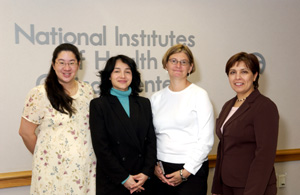 Pictured (l to r): Jennifer Low, NCI; Suzan Khoromi, NCCAM; Nataly Strunnikova, NEI; Farideh Eskandari, NIMH. Not pictured: Minoo Batiwalla, NHLBI; Vidya Sankar, Univ., Texas Health Sciences Ctr at San Antonio; Kazuki Takda, Tokyo Medical and Dental Univ.
Pictured (l to r): Jennifer Low, NCI; Suzan Khoromi, NCCAM; Nataly Strunnikova, NEI; Farideh Eskandari, NIMH. Not pictured: Minoo Batiwalla, NHLBI; Vidya Sankar, Univ., Texas Health Sciences Ctr at San Antonio; Kazuki Takda, Tokyo Medical and Dental Univ.
|
Members of the 2003-2004 class of the NIH-Duke University Training Program in Clinical Research gathered for a luncheon in their honor on May 4.
The program, established in 1998, is a joint collaboration between the Duke University School of Medicine and the Clinical Center's Office of Clinical Research Training and Medical Education. To date, 31 participants representing various NIH institutes or centers have completed the training.
The program, which provides NIH physician scientists with formal academic training in the quantitative and methodological principles of clinical research, leads to a Master of Health Sciences in Clinical Research, conferred by the Duke University School of Medicine.
For more program information, call the Office of Clinical Research Training and Medical Education at 301-496-9425.
Back
to Top
Clinical Center greets 2004 clinical fellows
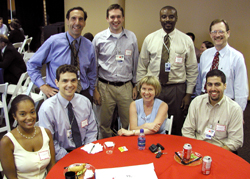 From l-r: Antoinette Williams, fellow, Critical Care Medicine Department, Clinical Center (CCMD); Daniel Sweeney, fellow, CCMD; Henry Masur, M.D., chief, CCMD; Christopher Barnett, fellow, CCMD; Dorothea McAreavey, M.D., CCMD fellowship program director; Lawrence Osei, fellow, CCMD; Michael Cuttica, fellow, CCMD; and James Shelhamer, M.D., deputy chief, CCMD.
From l-r: Antoinette Williams, fellow, Critical Care Medicine Department, Clinical Center (CCMD); Daniel Sweeney, fellow, CCMD; Henry Masur, M.D., chief, CCMD; Christopher Barnett, fellow, CCMD; Dorothea McAreavey, M.D., CCMD fellowship program director; Lawrence Osei, fellow, CCMD; Michael Cuttica, fellow, CCMD; and James Shelhamer, M.D., deputy chief, CCMD.
|
Nearly 100 new clinical fellows were guests of honor at a barbecue reception in the B1 cafeteria in July. The event was moved inside when storm clouds gathered.
"This is really an orientation program for the new fellows who have arrived at NIH for the new academic year, which typically begins July 1," said Frederick P. Ognibene, M.D., director of the Clinical Center's Office of Clinical Research
Training and Medical Education. "They are in a number of programs—both those accredited through the Accreditation Council for Graduate Medical Education and those in other clinical training programs at NIH."
Because of the diversity of backgrounds and the number of programs, many of the fellows didn't know each other, but flocked to tables where others in their field were dining. Afterwards, Ognibene and Clinical Center Director John I. Gallin went from table to table, chatting with the participants.
"These clinical fellows are not only from around the country but from around the world," said Gallin. "They've come here to learn how to do clinical research and to determine if this is how they're going to spend their careers."
The fellows stay anywhere from three to five years, depending on the program. Some programs offer board certification in specialty areas while others are geared towards those who are already board certified. "These people," said Gallin, "are the ones who go on to become the leaders of clinical research, not only here, but throughout the country and the world."
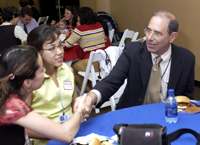 Dr. John I. Gallin makes acquaintances with two of the 2004 fellows at the reception held last month.
Dr. John I. Gallin makes acquaintances with two of the 2004 fellows at the reception held last month.
|
"After the event today," said Ognibene, "they'll all have very focused training in their own clinical specialties. And many will do their training at partner institutions, including the National Naval Medical Center, Walter Reed, and Johns Hopkins, Georgetown and George Washington Universities."
Antoinette Williams, M.D., a fellow studying critical care, said she expects her stay to be nothing short of a "great experience." From South Carolina she applied to the fellowship program on the advice of one of her physicians. "I came here and fell in love with the place," she said. "The faculty and campus were wonderful. I didn't have a strong research background, so to me it's a tremendous opportunity. It's also very hot in the summer, so it reminds me of home!"
Vitalie Lupu, M.D., graduated from a neurology residency at Georgetown University Hospital. He's here from the University of Moldova, for an electromyography fellowship in the Neurophysiology Program. "I've finished medical school," he said, "and will probably be here for two years and do a second year of research training."
Sarah Pirio Richardson, M.D., of the University of California, Sacramento, is here in the Clinical Nurse Science Division. She learned of the fellowship program at a neurology conference in San Francisco. There she met Dr. Mark Hallett (NINDS), was interviewed in a nearby park, and was accepted. "I knew I didn't need to see the place to accept the job," she said. "The reputation speaks for itself. I'm just happy to see that everyone is so nice, and that the campus is so beautiful." "Clinical research training," said Gallin, "has been one of the NIH's unique features for many years. The program has trained many of the leaders of the nation's clinical research enterprise, from chairmen of various departments to current deans, some Nobel laureates—it all started here." -John Iler Back
to Top
August Grand Rounds |
| 4 |
Wednesday, 12 noon–1 p.m., Grand Rounds for Fellows
Separating the Wheat from the Chaff: Critical Reading of the Biomedical Literature
Michael Gottesman, M.D., deputy directory for Intramural Research, NIH
|
| 11 |
Wednesday, 12 noon–1 p.m., Grand Rounds for Fellows
The Ethics of International Clinical Trials
David Wendler, Ph.D., Head, Unit on Vulnerable Populations, Clinical Bioethics Department, NIH Clinical Center |
| 18 |
Wednesday, 12 noon–1 p.m., Grand Rounds for Fellows
Health Disparities in a Health Policy Context: From Discrimination
to Quality
Sara Rosenbaum, J.D., Hirsh Professor and Chair, The George Washington University Medical Center School of Public Health and Health Services |
| 25 |
Wednesday, 12 noon–1 p.m., Grand Rounds for Fellows
Health Disparities Among the Pima Indians With Special Emphasis on Diabetes Mellitus
Peter H. Bennett, M.D., scientist emeritus, Phoenix Epidemiology and Clinical Research Branch National Institute of Diabetes and Digestive and Kidney Diseases, NIH |
Back
to Top
Phase I of ACRF parking project underway
Phase one of the ACRF parking restoration project began in mid-July and is scheduled for completion before Thanksgiving. In this phase of restoration, portions of the P1 level of the parking garage near the lobby entrance to the CRC will be repaired and remodeled, as well as portions on the northwest side, areas adjacent to the ramp, and the east end of the garage at P1, P2 and P3 levels.
These areas of the garage were used for storage during construction of the Hatfield Clinical Research Center. With the repair and remodeling of the P1 area of the garage being completed, the spaces were released, but must be renovated before being opened for parking. When the garage restoration is complete, about 70 more parking spaces will be available. Some should be available by Thanksgiving.
Employees will also have access to nearly 90 more parking spaces on the P2 and P3 parking levels, but it may be another three months before the spaces are available.
"We just want to inform employees that this is happening, because they may see a lot of empty spaces in the P1, P2 and P3 garage areas and wonder why they are not in use," said Don Sebastian, CRC project manager.
The work will be completed at night and on weekends, according to Ben Buck, project officer. Restoration will involve the repair of worn spots and the installation of energy-efficient lighting, new paint and striping, and improved signage. Other parts of the garage will be renovated in later phases. The complete renovation, Buck said, will take about 18 months.
Back
to Top
CRIS update
The CRIS Steering Committee and the CRIS Project Management Team have selected Saturday, August 21, as the new go-live date for CRIS.
Technical issues caused a delay in the original go-live date of July 31. The additional three weeks will allow time for extensive testing of all aspects of the system and to review and address all questions that have been raised during user acceptance testing.
The project management team previously requested that no future-dated orders be entered into MIS for activation after August 1. Staff may continue to enter these orders as needed, as long as they are activated before August 20.
Back
to Top
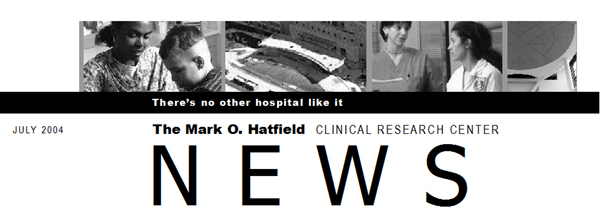 |
Construction crews race to finish new
hospital
Q: How many sinks does it take to make a hospital?
In a hospital built to accommodate 242 inpatients, with 80 stations for outpatients, plus assorted labs, how many sinks do you guess have been installed? |
Twice a year construction crews working on the new Hatfield Clinical Research Center (CRC) are invited to a Safety Incentive and Appreciation Luncheon, typically featuring pep talks, incentive awards, and all the barbecue they can eat. The lunch held June 24 was the last. Crews are racing to meet the deadlines for
turning the building over to NIH.
Boston Properties, the development management firm managing the whole project, and Centex, the firm managing construction, are rightly proud of their safety record. No lives have been lost in construction, accidents and lost-time incidents are well below average, and by all standards by which the Occupational Safety and Health Administration (OSHA) measures safety, the team building the CRC has an excellent safety record.
 CRC construction crews take part in their annual Safety Incentive and Appreciation Luncheon.
CRC construction crews take part in their annual Safety Incentive and Appreciation Luncheon.
|
Subcontractors must send supervisors to OSHA's 10-hour safety course as well as a course in first aid before starting work. "We see that people go home in the same shape they came in," says safety director Charles Johnson.
"Our insurance carrier is happy," says Richard Ryan, the Centex executive in charge of bringing construction in on schedule, to quality standards, and within budget. "Everyone wins." Centex plans to sustain that safety record, despite the tension of a looming deadline and that last 10 percent of construction, when unexpected problems surface.
"We're really in a race against time," said John I. Gallin, director of the NIH Clinical Center—to which the CRC is both an addition and an upgrade. "Some serious medical problems are being studied here," he told the construction workers, urging them to finish the building by the end of August.
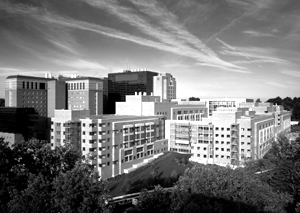 No lives have been lost in construction, accidents and lost-time incidents are well below average, and by all standards by which the Occupational Safety and Health Administration (OSHA) measures safety, the team building the CRC has an excellent safety record.
No lives have been lost in construction, accidents and lost-time incidents are well below average, and by all standards by which the Occupational Safety and Health Administration (OSHA) measures safety, the team building the CRC has an excellent safety record.
|
It takes a long time to build a state-of-the-art research hospital. Site preparation, including the realignment of Center Drive, began seven years ago and construction proper has taken five and a half years. Roughly 500 people a day have worked on construction (peaking at 900) for five and a half years, putting in $5.6 million in construction man-hours to date, reports Richard Ryan, of Centex. In other words, "it would have taken one man working alone about 2,800 years to build the place."
Of course, workers specialize. The current daily breakdown in trades, says Ryan, is this: roughly 15 painters, 10 people installing flooring, 75 carpenters, 75 drywall workers and finishers, 85 plumbers, steamfitters, and sheet metal workers, 90 electricians, 50 laborers, 20 people installing building controls, 15 installing telecommunications, and 65 doing other work.
Construction crews arrive between 6 and 7 a.m., starting their workday early to beat the traffic. They come from as far away as Ellicott City, West Virginia, and southern Maryland. Some would rather come at 5 a.m., but that was deemed too early. Their workday ends at 2:30 p.m., early enough to beat the rush home. Many of the workers are Hispanic.
The crews we spoke with seem content with the steady and interesting work.
 Construction crews come from as far away as Ellicott City, West Virginia, and southern Maryland. Many of the workers are Hispanic. Maria Hernandez (right) is a sheet metal worker and speaks no English. With her is waterproofing crew leader Gary Atencio.
Construction crews come from as far away as Ellicott City, West Virginia, and southern Maryland. Many of the workers are Hispanic. Maria Hernandez (right) is a sheet metal worker and speaks no English. With her is waterproofing crew leader Gary Atencio.
|
Richard Cherba's firm, Pierce Associates, Inc., is installing the mechanical systems needed for plumbing, heating, ventilation, and air-conditioning (HVAC). The CRC is a complex structure with built-in redundancies to keep it from shutting down unnecessarily.
"It's an impressive place in sheer number of heating and cooling devices," adds Matt Corrigan, also of Pierce. "The size of the contract is unbelievable." For example, Pierce and its subcontractors have installed nearly 1,500 sinks (hand-washing being highly valued in a hospital).
Nearly 5,000 variable-air-volume (VAV) boxes, which regulate the temperature and air flow to individual labs, patient rooms, and other sectors of the building.
 Clinical Center Director Dr. John I. Gallin gives a hearty handshake to Richard Cherba (right), of Pierce Associates, Inc.
Clinical Center Director Dr. John I. Gallin gives a hearty handshake to Richard Cherba (right), of Pierce Associates, Inc.
|
Over 100 miles of copper, steel, cast iron and plastic piping. For heating, air-conditioning, and cooling (HVAC) alone, they need piping to provide steam, chilled water, re-heat water, lab gasses, and medical gasses.
Over 2.4 million pounds of sheet metal (for ductwork and air-moving equipment).
Nearly 100 supply and exhaust fans, which work under automated control sequencing to constantly regulate the air pressure and temperature in highly sensitive areas of the building. (Another contractor, Johnson Controls, provides controls for rooms with negative and positive airflow—no airflow out for infectious patients, positive airflow out for immune-suppressed patients.)
It takes 18 to 24 months to build a typical office building, says Jim Hart, the Boston Properties executive in charge of the whole project. It took about five years to build the Reagan Building. The CRC, because it houses cutting-edge research and patient care, is a more complex structure, so it's not surprising it would take seven years to build.
- by Pat McNees
Medicinal plants for a healing place
Adorning the glass-enclosed pedestrian bridges connecting wings of the new Hatfield Clinical Research Center (CRC) will be container plantings. Many of those on floors 3, 5, and 7 will feature medicinal plants—the result of a collaboration between the NIH Clinical Center and the U.S. Botanic Garden (USBG).
The Botanic Garden is contributing the plants, says exhibit specialist Lillian Fitzgerald. Rob Pennington, manager of horticulture at the USBG, toured the CRC to help assess which plants are suited to light conditions in the hospital.
For thousands of years herbs were used to soothe, to reduce fever, and to heal wounds. Through trial and error, various cultures learned which plants were safe to eat and which routinely reduced symptoms. As medicine became a science, Western physicians turned from herbal treatment to drugs synthesized in laboratories, and pharmaceutical firms labored to discover the active ingredients in plants commonly used in folk remedies—not an easy task, according to literature from the Botanic Garden. In 40 years, the FDA has approved fewer than a dozen plant-based drugs, and "after nearly 70 years of using a relatively small family of wonder drugs, physicians and patients alike are rediscovering medicinal plants."
Those with medical potential are hot commodities—which is good and bad.
The success of the drug Taxol with ovarian and breast cancer patients posed a threat to the Pacific yew (Taxus brevifolia), because an entire tree's bark was needed to process a single gram of Taxol, and the wild tree is slow growing. The species survived overharvesting because scientists discovered how to combine the core molecule from the yew with a synthetic side chain produced in laboratories. That story and others like it dramatize the need to conserve plants in the wild.
Among plants chosen for display in the bridge areas are the following:
Madagascar Periwinkle (Catharanthus roseus), the dried whole plant of which contains more than 50 alkaloids, two of which are used to treat malignant cancers, Hodgkin's disease, metastatic testicular carcinoma and childhood leukemia. It has been used traditionally in many cultures to treat diabetes, indigestion, constipation, and other ailments. It was research into the claim that the plant treats diabetes—a claim that has not been substantiated—that led to the discovery of its anti-cancer properties.
Stevia, Sweet Leaf of Paraguay (Stevia rebaudiana), extracts from which provide a food sweetener 300 times sweeter than sugar. In Brazilian herbal medicine, stevia is used as a tonic for diabetes, hypertension, and high blood pressure—uses that the Botanic Garden says have been validated in American clinical studies. Danish researchers have demonstrated that stevia may prove useful in the treatment of diabetes.
Camphor tree (Cinnamomum camphora), the leaves of which make the skin feel cooler and, by depressing cutaneous receptors, provide relief from topical pain and itching. Rubbed on the throat and chest or used in steam inhalers, ointment containing camphor acts as a local anesthetic on lungs and throat.
Betel leaves (Piper betel), a mild digestive stimulant which relieves gas and prevents intestinal worms. Recent research has shown that betel leaves strengthen the immune system and can inhibit certain cancer cells. But chewing betel will eventually blacken the teeth and may promote mouth and tongue cancer.
Gotu kola (Centella asiatica), an herb whose active ingredients appear to stimulate collagen synthesis and hence the regrowth of normal connective tissue under the skin.
Root Beer Plant, Mexican Pepperleaf (Piper auritum), essential oils from which contain safrole, the pleasant odor (think root beer) of which gives the plant its name. Safrole is primarily an antiseptic, a stimulant, diaphoretic (increases sweating), and diuretic (increases urine output). The plant's fresh leaves are used as a spice in tropical Mexican cuisine.
Classic Myrtle (Myrtis communis), the leaves of which are tonic, astringent, and antiseptic. The essential oil is used as a decongestant for bronchitis and as a remedy for digestive and urinary disorders. It contains tannins, flavonoids, and the volatile oils alphapinene, cineole, and myrtenol. The leaves, fruits, and flowers are used in traditional Ayurvedic medicine to treat a wide range of ailments.
Holy Basil (Ocimum tenuiflorum). Useful in treating some types of diabetes, helps lower blood pressure, and has anti-inflammatory, analgesic, and fever-reducing properties. In Indian herbal medicine, the leaves of holy basil are used to relieve fevers, bronchitis, asthma, stress, and canker sores.
Arabian jasmine (Jasminum sambac), used in India to impart a cooling sensation and to treat insanity, weak vision, mouth sores, and eye irritation. The flowers are made into a calming infusion taken internally to relieve tension. A poultice of dry leaves is applied to indolent ulcers and other skin diseases. The oil from the flowers is used to treat dry skin.
Khat (Catha edulis), the leaves and twigs of which contain a volatile oil and Ephedrine-type alkaloids. Such alkaloids strongly stimulate the central nervous system, are antiallergenic, and suppress the appetite. Traditionally khat was used to combat fatigue and to help people go without food for extended periods.
This article is drawn from literature created for the medicinal plants exhibit at the U.S. Botanic Garden.
|
|
Editor:
John Iler
Contributing
writers: Colleen Henrichsen, John Iler, Pat McNees, Dianne Needham |
|
Clinical Center News, National Institutes of Health, 6100 Executive Blvd., Suite 3C01, Bethesda, MD 20892-7511. Tel: 301-496-2563.
Fax: 301-402-2984. Published monthly for CC employees by the Office of Clinical Center Communications, Colleen Henrichsen, chief. News,
article ideas, calendar events, letters, and photographs are welcome.
Back
to Top
|
|


